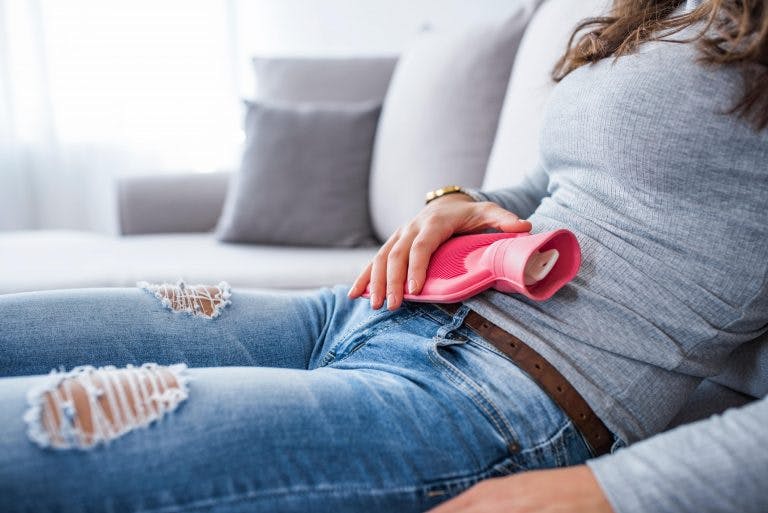Reviewed by Dr Eki Wari on February 21, 2022
6 Common Myths About Menstrual Cramps Debunked
Published | 5 min read
Listen, your friends are great, but they don't always give the best advice about period pain. In this article, our TCM physicians debunk several myths about menstrual cramps so you can get the facts straight.
Menstrual cramps are an annoying fact of life for many women. To make matters worse, they can range in severity from month to month without any real triggers.
This makes managing menstrual cramps a difficult task. If you ask your friends for help, you might get some inaccurate information.
In this article, our physicians debunk several myths related to period pain so you can get the facts straight and better manage your menstrual cramps.
Myth 1: All Menstrual Cramps Are The Same
According to physician Anita Pee, a Traditional Chinese Medicine (TCM) practitioner at Eu Yan Sang, “Menstrual pain varies between women. It can be an ache in the lower abdomen, lower back, or thighs. Some women experience very severe cramps, like a stabbing pain, which are not similar to any other types of pain.”
She adds that it can be unrealistic to expect all women to experience the same type and intensity of pain during their menstruation.
Myth 2: Debilitating Menstrual Cramps Are Normal
“Do not ignore it just because everyone suffers from it,” physician Pee advises. Women who do not respond to treatment after three months might be suffering from other underlying medical conditions and should get treatment as soon as possible.
Although menstrual pain occurs in up to 80% of menstruation women, it should not be debilitating. Behavioral factors, body mass index of less than 20 or more than 30 kg/m2, as well as smoking and caffeine consumption, can increase your risk and intensity of menstrual pain. With proper treatment and lifestyle changes, you can alleviate menstrual pain.
Myth 3: They Are Caused By Hormonal Imbalances
Menstrual pain occurs when there is excessive production of chemicals called prostaglandins by the uterus lining. In addition to directly stimulating the pain receptors, prostaglandins also cause strong contractions of the uterine muscles, reducing the oxygen supply and resulting in cramps.
However, menstrual pain may also occur due to other underlying medical conditions such as endometriosis and adenomyosis, resulting from abnormal uterine lining growth. If your monthly pain is indeed unbearable, you should get yourself checked for these conditions by a gynaecologist.
In Western medicine, non-steroidal anti-inflammatory drugs (NSAIDs) can help alleviate menstrual pain by reducing prostaglandin production. They provide only symptomatic relief, which does not last after the effects of the medicine wear off. A research paper stated that NSAIDs failed to relieve menstrual pain in about 20% of women. Prolonged intake or taking this medicine on an empty stomach may also cause acidity and heartburn.
Physician Pee shares that in TCM, menstrual pain is mainly related to the body constitution. Women with liver qi (vital life energy) stagnation (due to high-stress levels), cold body constitution (from consumption of cold foods), and weaker body constitution (resulting from excessive blood loss or overexertion) tend to experience mild to severe cramps.
“TCM can treat each of these types accordingly using herbs. If the condition gets better, naturally the next period will not cause extreme pain,” she adds.
Regardless of your treatment choice, consult a medical professional if menstrual pain disrupts your quality of life.
Myth 4: Exercise Makes It Worse

Studies show that regular exercise can help to reduce menstrual pain. Exercise releases endorphins, which helps block the pain receptors in the brain and improve circulation, including in the uterus, thereby providing pain relief. For those on a heavy period, physician Pee recommends brisk walking, yoga, jogging, and traditional exercises like qi gong and tai chi.
Myth 5: Don’t Shower Or Wash Your Hair
“It’s not true that you can’t bathe or wash your hair when you have your period. On the contrary, we have to be very careful about our hygiene during this time,” physician Pee says, adding that women should use warm water to shower or bathe.
“You should also quickly dry your hair before stepping out. In TCM, we avoid getting cold air into wet hair since it can cause cold and dampness to the body, which is not so good for people with menstrual pains.”
Myth 6: Acidic Foods Worsen Menstrual Cramps
There is no need to avoid acidic foods. However, physician Pee stresses the importance of abstaining from cold drinks and foods. She suggests drinking ginger and brown sugar tea before menstruation to warm the uterus and lessen the cramps. Herbs and moxibustion can also help to alleviate the pain.
Before and during the period, dang gui (当归), tao ren (桃仁), hong hua (红花), and yan hu suo (延胡索) can improve blood circulation and remove blood clots. You can find these herbs in formulations such as jia wei xiao yao san (加味逍遥散), tao hong si wu tang (桃红四物汤) and bak foong pills (白凤丸).
After menstruation, tonifying herbs that build up the body constitution and warm the uterus include dang shen (党参), bai zhu (白术), huang qi (黄芪), shu di huang (熟地黄) and ai ye (艾叶). Ba zhen tang (八珍汤) and shi quan da bu tang (十全大补汤) are common formulations containing these herbs.
“Please consult a TCM physician to help you choose the right herbs for your menstrual pain. Beware of certain herbal supplements sold in stores as they may not be appropriate for all women,” reminds physician Pee.
Menstrual pain is common, but the underlying cause may be more serious than you think, especially if it severely impacts your quality of life. If you face immense menstrual pain every month, consult your doctor or TCM practitioner for professional advice.
References
- Revista Brasileira de Ginecologia e Obstetrícia. 2020. Primary Dysmenorrhea: Assessment and Treatment.
- PLOS One. 2017. Moxibustion for pain relief in patients with primary dysmenorrhea: A randomized controlled trial.
- Cochrane Database of Systematic Reviews. 2019. Exercise for dysmenorrhoea.
- Women’s Care. 2021. How to Relieve Period Cramps: Exercise and Home Remedies.
- Taiwan Association of Obstetrics & Gynecology. 2018. Effect of Ginger and Novafen on menstrual pain: A cross-over trial.
Share this article on

